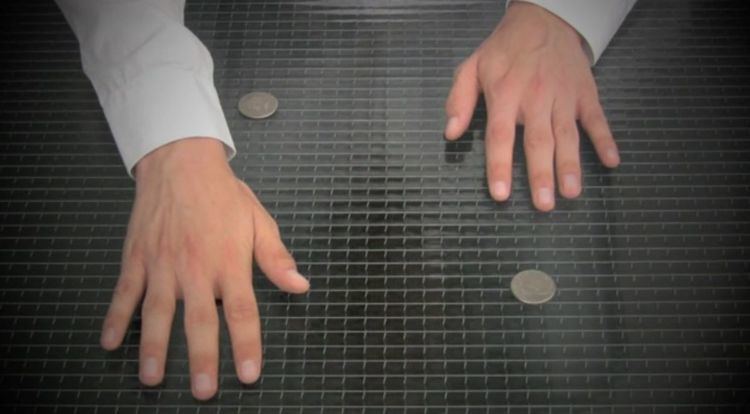 | ||
Chink-a-Chink is a simple close-up magic trick in which a variety of small objects, usually four, appear to magically transport themselves from location to location when covered by the performer's hands, until the items end up gathered together in the same place. Variations, especially the Sympathetic Coins, have been performed since the 1800s. Popular variations are Shadow Coins, Coins-n-Cards and Matrix. A variation using playing cards as the objects is known as Sympathetic Aces.
Contents
Effect
In the typical layout, the magician places four small objects on a table in a square, rectangular or diamond formation (although even a single straight line formation is possible). The objects are usually equidistant from each other. The magician then covers any two of the objects with his hands, performs a flourish, and then lifts his hands to reveal that one of the objects has somehow jumped from its original location to join one of the other three objects. The same effect is repeated until all of the objects are gathered together in a single location. Objects most commonly used for the trick are wine corks, dice, bottle caps, brass weights, and coins (the latter usually being used in a variation of the trick known as "Matrix", generally credited to the modern magician Al Schneider).
History
Sean McWeeney, the author of the first dedicated e-book on Chink-a-Chink has demonstrated that the trick is a lot older than was previously thought, with a history stretching back to at least early/mid-19th-century Germany. The trick was famously covered in Edwin Sach's seminal book Sleight of Hand in 1877, utilizing four sugar cubes. Hank Yoe is reputed to have performed it around the turn of the 20th century, and introduced the name Sympathetic Coins.
Max Malini, who popularized the trick in the early 20th century, using cut-down wine corks, is generally credited with naming the trick. Although the name was probably meant to be onomatopoetic, it can be interpreted as a racial slur and as a result has been given alternative names. Leo Horowitz perpetuated Malini's version while adding refinements of his own, using covered sugar cubes of a type popular in supper clubs and night spots in the 1930s, 1940s and 1950s. Doug Henning performed Chink-a-Chink on television in the early 1970s, using seashells. Dutch magicians Fred Kaps and Tommy Wonder were also associated with the trick.
Pre-fabricated Chink-a-chink sets are available on order from various magic-makers, including Auke van Dokkum of the Netherlands, François Danis of France and Jim Riser of the US. Professional magicians, however, generally prefer the traditional "found objects" (such as corks and bottle caps) to the artificial ones, reducing demand for the purpose-built sets.
Variations on the basic trick use two playing cards to cover the coins instead of the magician's hands.
